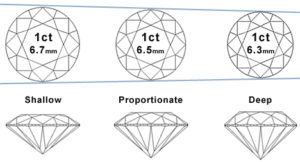In diamond terms, it refers to the face-up appearance of a stone, and one that you would call “spread” or having a good spread would appear larger than its actual carat weight might normally dictate. The term ‘Spread’ is an industry term that refers to a diamond’s face-up size compared to its weight. One can also call this as ‘weight ratio’ or ‘millimeter footprint vs weight’. Of course, you do not want a diamond that is so flat there is not enough depth to reflect light properly. There is however a happy medium of having a spready diamond and one that still has a very good or excellent cut to maintain its sparkle.
Theoretically, a standard or ideal Round Brilliant would have proportions such that a 1.00 Ct stone would have a diameter of 6.50mm. If one diamond is having a diameter of 6.82 mm which means the diameter is more by 5% in other words diamond spread ratio is Positive and by 5%, the same way when one diamond’s diameter is 5 % less than an ideal diameter, measured 6.17 mm which means spread is negative and by 5% in this case. On comparing any other diamond with this ‘Ideal’ diamond spread, if it has zero or no spread, then this diamond would be equal in size, weight, and proportions to the ideal diamond.

Diameter negative spread indicates diamond weight (in % terms) being in excess of what it ideally should be, whereas in the reverse case, positive spread indicates the diamond weight is less than the ideal. Spread Ratio can be positive and negative considering parameters like Girdle thickness, Depth, and Crown Height, etc. If there is excess weight due to all mentioned parameters – Spread is Negative and the diamond showing reduced weight due to thin girdle, flat crown, or shallow pavilion – Spread is Positive, Spread Ratio is the logical parameter for purchasing diamonds.

However, spread as a factor in purchasing diamonds functions as a precise indicator of whether a given diamond is actually justifying the price being asked. In other words, to a customer, the spread can clearly identify whether, for a given price, a diamond is carrying more weight than it ideally should or less.
90% of engagement ring shoppers would definitely prefer a larger looking stone but finding the perfect one that balances having a beautiful sparkle and a large surface area is no easy task. These little nuances that are usually oblivious to the average engagement ring shopper should not go overlooked because they can make or break the look of a ring and cause large fluctuations in prices. Sometimes negative spread diamonds can be sold at 10-20% lower than similar color and clarity diamonds.

This holds true across all diamond shapes but becomes even trickier with fancy shapes like ovals, cushions, etc because there are so many variations in these cutting styles. There are no actual cut grades on these fancy shape diamond certificates so it becomes that much more important to see the diamond in person or via HD quality video to ensure it has the right brilliance, perfect shape, and of course that wow factor – Ideal Spread Ratio
